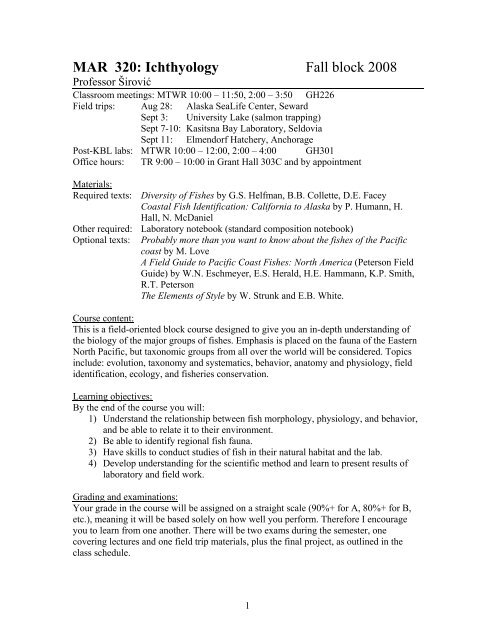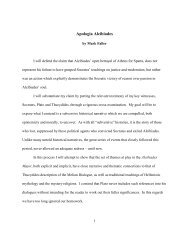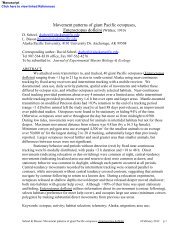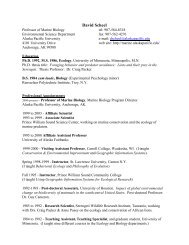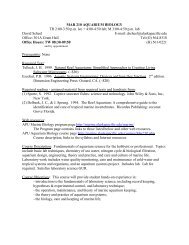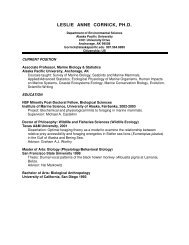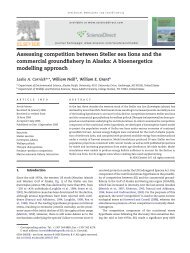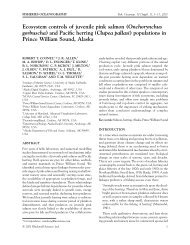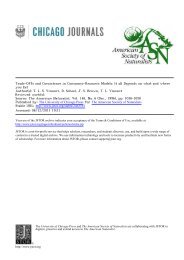Example Syllabus (.PDF) - MARINE BIOLOGY at Alaska Pacific ...
Example Syllabus (.PDF) - MARINE BIOLOGY at Alaska Pacific ...
Example Syllabus (.PDF) - MARINE BIOLOGY at Alaska Pacific ...
Create successful ePaper yourself
Turn your PDF publications into a flip-book with our unique Google optimized e-Paper software.
MAR 320: Ichthyology Fall block 2008Professor ŠirovićClassroom meetings: MTWR 10:00 – 11:50, 2:00 – 3:50 GH226Field trips: Aug 28: <strong>Alaska</strong> SeaLife Center, SewardSept 3: University Lake (salmon trapping)Sept 7-10: Kasitsna Bay Labor<strong>at</strong>ory, SeldoviaSept 11: Elmendorf H<strong>at</strong>chery, AnchoragePost-KBL labs: MTWR 10:00 – 12:00, 2:00 – 4:00 GH301Office hours: TR 9:00 – 10:00 in Grant Hall 303C and by appointmentM<strong>at</strong>erials:Required texts: Diversity of Fishes by G.S. Helfman, B.B. Collette, D.E. FaceyCoastal Fish Identific<strong>at</strong>ion: California to <strong>Alaska</strong> by P. Humann, H.Hall, N. McDanielOther required: Labor<strong>at</strong>ory notebook (standard composition notebook)Optional texts: Probably more than you want to know about the fishes of the <strong>Pacific</strong>coast by M. LoveA Field Guide to <strong>Pacific</strong> Coast Fishes: North America (Peterson FieldGuide) by W.N. Eschmeyer, E.S. Herald, H.E. Hammann, K.P. Smith,R.T. PetersonThe Elements of Style by W. Strunk and E.B. White.Course content:This is a field-oriented block course designed to give you an in-depth understanding ofthe biology of the major groups of fishes. Emphasis is placed on the fauna of the EasternNorth <strong>Pacific</strong>, but taxonomic groups from all over the world will be considered. Topicsinclude: evolution, taxonomy and system<strong>at</strong>ics, behavior, an<strong>at</strong>omy and physiology, fieldidentific<strong>at</strong>ion, ecology, and fisheries conserv<strong>at</strong>ion.Learning objectives:By the end of the course you will:1) Understand the rel<strong>at</strong>ionship between fish morphology, physiology, and behavior,and be able to rel<strong>at</strong>e it to their environment.2) Be able to identify regional fish fauna.3) Have skills to conduct studies of fish in their n<strong>at</strong>ural habit<strong>at</strong> and the lab.4) Develop understanding for the scientific method and learn to present results oflabor<strong>at</strong>ory and field work.Grading and examin<strong>at</strong>ions:Your grade in the course will be assigned on a straight scale (90%+ for A, 80%+ for B,etc.), meaning it will be based solely on how well you perform. Therefore I encourageyou to learn from one another. There will be two exams during the semester, onecovering lectures and one field trip m<strong>at</strong>erials, plus the final project, as outlined in theclass schedule.1
MAR 320: IchthyologyFall 2008Midterms (100 points each)Final present<strong>at</strong>ionFinal paperParticip<strong>at</strong>ion200 points100 points100 points50 pointsTotal points 450Examin<strong>at</strong>ions will be based on lectures, text readings, and handouts. There will be nomake-up exams, so please plan accordingly. Particip<strong>at</strong>ion grade is based on <strong>at</strong>tendance,contributions to class discussions, lab notebook, field trip particip<strong>at</strong>ion, and adherence toclass policies. Class and field trip <strong>at</strong>tendances are mand<strong>at</strong>ory. Each absence beyond 2classes will result in a full letter grade reduction. Read the Honor Policy in your C<strong>at</strong>alogand Behavior Expect<strong>at</strong>ions section of the Student Handbook for inform<strong>at</strong>ion on academicdishonesty. Please see me if you have any questions.Field work:We will spend 4 days conducting field work in Kasitsna Bay Labor<strong>at</strong>ory in Seldovia fromSept 7-10. You are expected to fully particip<strong>at</strong>e in prepar<strong>at</strong>ion for the trip and all aspectsof life in the field. This will include going over gear lists, compiling gear, cooking,cleaning up the facilities, etc. More inform<strong>at</strong>ion will be given in class and during logisticsmeeting prior to the trip. Please read, sign, and return Field Course Conduct Agreementby the end of class on Aug 25.Project report and present<strong>at</strong>ion:As a part of Active Learning in this class, you will undertake an independent researchproject. In the end, you will be expected to present your results in a written and oralform<strong>at</strong>. See “Project report guidelines” for guidance on how to write your final paper.Your final present<strong>at</strong>ion will be 15-20 minutes long, and you should be prepared to answerquestions about your research <strong>at</strong> the end of the talk. We will discuss further details ofpaper writing and cre<strong>at</strong>ing a successful present<strong>at</strong>ion in class.Before you start work on your project, make sure you have discussed your topic with meby Sept 9!Lab notebook:Your lab notebook helps you keep record of your work, so you can reconstruct youractions in the field and the lab. Keeping a detailed and well organized notebook is acrucial scientific skill. Use it to record lab assignments and observ<strong>at</strong>ions in the field, towrite down raw d<strong>at</strong>a, and track your d<strong>at</strong>a analyses and results. In short, use it to writedown everything and anything you think may be relevant to your project. You will turnthe lab notebook in with your project and it will contribute to your particip<strong>at</strong>ion grade. (Iwill not be looking for ne<strong>at</strong>ness, but for a full record of your project.)Support services:If you need disability-rel<strong>at</strong>ed accommod<strong>at</strong>ions, please notify Tamara Randolph, ourDisabilities Services Coordin<strong>at</strong>or (564-8345). Other services available to you include:2
MAR 320: IchthyologyFall 2008Counseling Center for personal concerns, tutoring from on-campus and communityresources, Academic Support Center (offers writing help), and Consortium Library.Other policies:• There is no e<strong>at</strong>ing in class.• Keep cell phones on silent and do not use them for calls or text messaging during class.• Refrain from talking about non-class rel<strong>at</strong>ed issues during lectures.• Use email only for short communic<strong>at</strong>ion. If you have lengthy questions about the class,grades, exams, etc. please come see me. These kinds of issues are always resolved morequickly in person than over email.• On-time arrival for field trips and classes is expected. If you are l<strong>at</strong>e, do not besurprised when miss the field trip.• Do your readings before each class. It will help you follow and get the most out oflectures and field work.• If you have any problems or need help, talk to me about it.This syllabus is our contract. Refer to it (often) to know wh<strong>at</strong> is expected of you in thisclass. You are responsible for meeting all the deadlines and for completing the requiredreading assignments prior to class.3
MAR 320: IchthyologyFall 2008Class schedule (subject to change):D<strong>at</strong>e Time Topic Readings8/25 AM Introduction; System<strong>at</strong>ics, evolution. Ch. 1, 2, 11*PM Families – Chondrichthyes. Ch. 128/26 AM An<strong>at</strong>omy: hard and soft parts. Ch 3*, 4PM Families – primitive fishes; Teleosts. Ch. 13*, 14*8/27 AM Locomotion and feeding. Ch. 8, 18, 19PM Families – Teleosts II. Ch. 15*8/28 7:45 am Field trip to <strong>Alaska</strong> SeaLife Center. Handout9/2 AM Life histories, growth. Ch. 9, 109/3 10 am –2:30 pmProject overview (in class). Salmon trapping <strong>at</strong>University Lake.9/4 AM Role of fishes in ecosystem: fisheries andconserv<strong>at</strong>ion.PM Kasitsna Bay Lab field trip logistics.9/7 10:30 am Leave for Homer. Shuttle to Kasitsna Bay.Ch. 24, 25Evening Behavior: Reproduction, communic<strong>at</strong>ion, etc. Ch. 20, 21*, 22*9/8 AM/PM Bo<strong>at</strong> trip & lab: ID, morphometrics. HandoutEvening Good paper writing and present<strong>at</strong>ion skills. Handout9/9 AM/PM Bo<strong>at</strong> trip & lab: an<strong>at</strong>omy, dissection. HandoutEveningStudy time.9/10 AM Midterm (lectures). Clean-up. Prepare fordeparture (noon).PM Return to Anchorage. Rinse gear.9/11 10 am Field trip to Elmendorf H<strong>at</strong>chery.PMGrad student led lecture/discussion.9/15 AM Midterm – field trips (in GH226); Work onprojectPM Work on project9/16 AM Work on projectPM9/17 AM Work on projectPMDraft of project paper due; Work on projectFinish up project9/18 AM Final present<strong>at</strong>ions (in GH226)PMFinal present<strong>at</strong>ions (in GH226)9/22 No class; Project papers and lab notebooks due* You are responsible only for parts of chapter covered in class.4


